What is Dot and Dab Plasterboard?
Dot and Dab is the name for a specific type of plasterboard dry lining where plasterboard is literally stuck to internal masonry walls with blobs of plasterboard adhesive.
In the image below you can see a block wall with two blobs of plasterboard adhesive. On the adhesive is a sheet of plasterboard which leaves a gap of about 25mm between the blockwork and the internal face of the board.
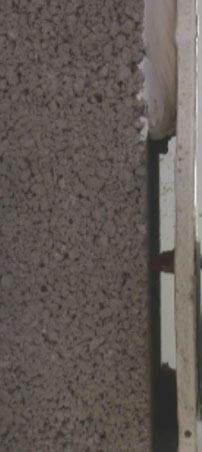
Plasterboard stuck to blockwork in dot and dab wall
A screw, in this gap, is not supported and any heavy load applied to the end of it will cause the screw to bend.
Dot and Dab is a very quick method of lining a room with plasterboard and has a huge speed advantage over wet plastering.
It does however have a few pitfalls, not the least of them being thermal bridging where the cold temperature of the masonry is transferred, via the plasterboard adhesive, to the inside of the plasterboard wall.
This can result in cold spots on the wall which, in turn can result in condensation and condensation around the window reveals of a dot and dab plaster boarded room is very common.
This downside however, is nowhere near as common as the problem of trying to fix heavy objects such as large flat screen TVs and kitchen cupboards to a dot and dab wall.
We will discuss this, and the wonderful advantage of Corefix a little further on. First, take a look at the video above where you will see just how powerful the Corefix dot and dab plasterboard fixings are.
Why is Fixing to Dot and Dab Plasterboard a Problem?
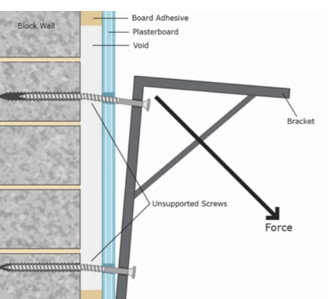
Corefix overcomes the problem of screws pulling out of plasterboard dot and dab
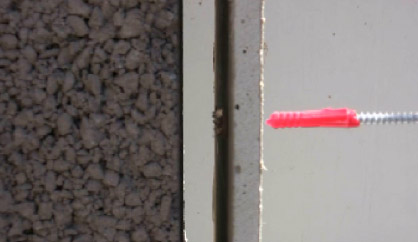
Normal plug and screw being pushed into dot and dab plasterboard wall
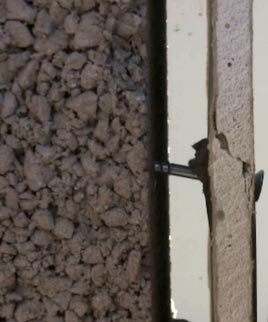
Dot and dab does not support the screw so it bends under load
Holes can be drilled into dot and dab plasterboard walls just the same as ordinary block walls. A wall plug can then be pushed gently onto a screw and the screw pushed through the hole in the plasterboard and through into the blockwork.
The screw can be “unscrewed” thus leaving the wall plug in the blockwork ready to attach something like a TV bracket or shelf to the wall.
However, there will always be an unsupported section of screw between the blockwork and the plasterboard. When any weight is applied to the screw, it will bend.
Because it is bent, the downward force of the attached object starts to tilt outward as the image above shows. This stops the force being 100% downwards and moves it to an angle which, after time, starts to pull the screw out of the wall.
This is the number one problem with using ordinary plugs and screws to a dot and dab plasterboard wall.
How Does Corefix Work?
We know the problem with fixing to dot and dab is the unsupported length of screw between the wall and the board. Corefix decided to keep it very simple and say that the solution is obviously to find a way of supporting it! And boy have they done that!
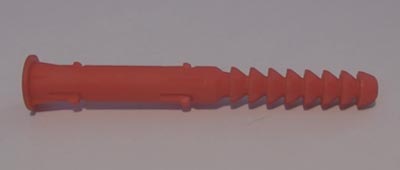
Using a 10mm plug allows Corefix to support the screw over a dot and dab cavity
Using a 4-inch wall plug, with the main body of the plug at a 10mm diameter, the Corefix wall plug is pushed into a 10mm hole. It is not pushed through the plasterboard however as the lip at the head of the plug will prevent that happening.
Once the plug is in the wall, a steel tube is pushed into the end of the plug. This tube is hollow and very very strong. It is long enough to go right through to the masonry wall where it, after being hammered home, forms a really tight fit about 25mm into the masonry wall.

Steel tube used in Corefix’s dot and dab plasterboard wall fixing
The steel tube, as you can see from both the video and the image below, bridges the gap in the dot and dap wall. 50% of the steel tube is held in the masonry which is how the load is supported at the other end of the screw.

Reinforcing tube being hammered into Corefix Dot and Dab fixing system
On Site Test of Corefix Dot and Dab Plasterboard Fixings
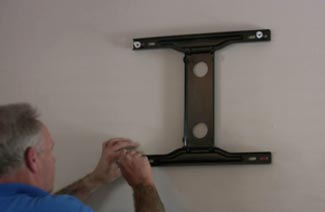
Using Corefix Dot and Dab plasterboard fixings to hold up a TV bracket
We took a DIY bag of 4 Corefix to site to hang a TV bracket. This particular TV braacket is called a Tranquil Mount Bracket and is designed to hang your Tv at the height you choose over any mantel.
It pulls away from the wall thereby holding heavy TV’s quite a distance away from its fixings. To do all these things the TV bracket has to be extremely well made and very strong. It’s therefore quite heavy.
Normal screws, plugged into the blockwork behind the dot and dab plasterboard would pull out in an instant; Enter Corefix!
As the video shows, fixing the TV bracket was simple. We market the screw holes on the wall, drilled 4 x 10mm holes, inserted 4 Corefix fixing and screwed the bracket up.
No amount of pulling, pushing and twisting will tear that bracket down now. Corefix fixings are, in our opinion, Genius, as I may have mentioned a couple of times in the video!
What can Corefix Dot and Dab Plasterboard Fixings Hold?
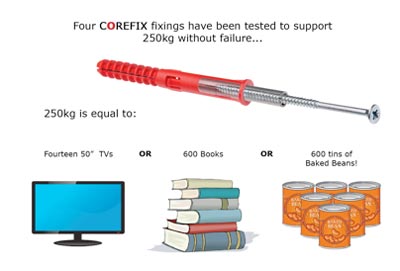
Four Corefix fixings can hold up to 250kg without failure
In 2017 statistics show that almost 80% of people are installing TV’s which range between 40 and 55 inches (Source Statisista.com).
These sizes of TV take up a huge amount of room on the sideboard and mantel piece so more and more TV brackets are being sold.
At the same time, more and more developers are using dot and dab plasterboard as a quick, easy ways to line homes. Due to this, TV brackets are getting harder to fix as are bookshelves, kitchen cupboards and anything else better placed on the wall.
The diagram shows what Corefix can hold and 250kg is almost 39.5 stone or 3/4 averagely built people – That is very impressive indeed.
How and Where do I buy Corefix?
Corefix can be bought from most high street DIY stores today including B&Q, Screwfix and the similar.
If you live in a modern house I would very strongly suggest you buy a trade pack of 24 fixings whether you are in the trade or not!
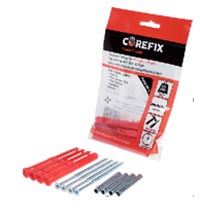
The Corefix DIY pack containing 4 Corefix fixings
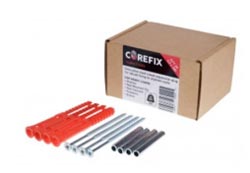
The Corefix trade pack containing 24 Corefix fixings
Value for money does not get much better than this. 24 Corefix fixings in a box at less than £1 each and the time, labour, effort and pain saved is incredible.
DIY Doctor Opinion of Corefix Dot and Dab Plasterboard Fixings
It’s no secret, we love them! This hideous problem that has plagued us (and many many others) for many many years has now magically gone away thanks to Corefix.
Corefix is a relatively simple solution to a very big problem and we think these fixings deserve a place in everyone’s tool box.
The Doctor’s Rating
Reviewed by: Mike Edwards

(5 out of 5 stars)
Get This Product Now

